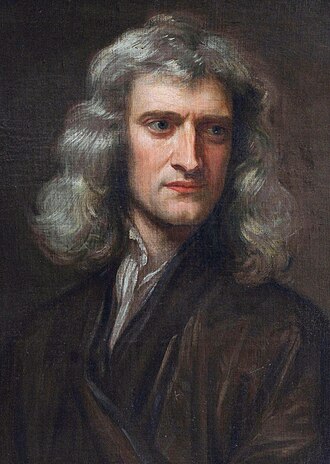Isaac Newton
A key figure in the scientific revolution

Here's a time line of Sir Newton's life:
- 1642- Born in Lincolnshire, England.
- 1654- Went to the King's School, Grantham, which taught Latin and Greek and probably imparted a significant foundation of mathematics on him.
- 1659-Removed from school briefly by his mother to become a farmer.
- 1661- Admitted to Trinity College, Cambridge, on the recommendation of his uncle Rev William Ayscough who had studied there.
- 1665- Discovered the generalised binomial theorem and began to develop a mathematical theory that would later become calculus.
- 1666- Develops theories in calculus, optics, and the law of gravitation from his home in Woolsthorpe while his university was temporarily closed as a precaution against the Great Plague.
- 1667- Returned to Cambridge in October and was elected as a fellow of Trinity.
- 1670-72- Lectured on optics and observed that colour is the result of objects interacting with already-coloured light rather than objects generating the colour themselves.
- 1675- In his Hypothesis of Light, Newton posited the existence of the ether to transmit forces between particles. With revived interest in alchemy, he replaced the ether with occult forces based on Hermetic ideas of attraction and repulsion between particles.
- 1679- Returned to his work on (celestial) mechanics by considering gravitation and its effect on the orbits of planets with reference to Kepler's laws of planetary motion.
- Early 1680's- After exchanges with Hooke, Newton worked out proof that the elliptical form of planetary orbits would result from a centripetal force inversely proportional to the square of the radius vector.
- 1687- First edition of the Principia, considered as one of the most important works in the history of science, was published.
- 1689-90- Served as a member of the Parliament of England for Cambridge University, but according to some accounts, his only comments were to complain about a cold draught in the chamber and request that the window be closed.
- 1696- Takes up the post of warden of the Royal Mint.
- 1703- Made President of the Royal Society in 1703 and an associate of the French Académie des Sciences.
- 1705- Queen Anne knighted Newton during a royal visit to Trinity College, Cambridge. The knighthood is likely to have been motivated by political considerations connected with the Parliamentary election in May 1705, rather than any recognition of Newton's scientific work or services as Master of the Mint.
- 1727- Died in his sleep in London and was buried in Westminster Abbey.
"No one must think that Newton’s great creation can be overthrown in any real sense by this [Theory of Relativity] or by any other theory. His clear and wide ideas will for ever retain their significance as the foundation on which our modern conceptions of physics have been built."
Read more about Isaac Newton on his Wikipedia Entry where much of this tribute page was sourced from.
Written and coded by Dereje Getahun.